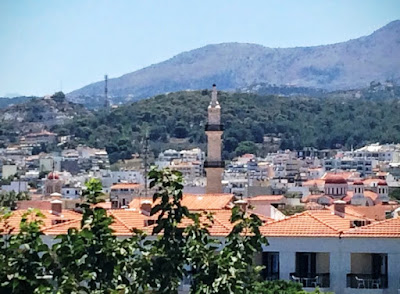Colourful steps at the top of Cheimárras Street in Rethymnon, close to the entrance to the Fortezza (Photograph: Patrick Comerford, 2016)
Patrick Comerford
Cheimárras Street is a colourful, narrow, winding street in Rethymnon that twists and turns its way from the old Venetian Fortezza that crowns the heart of the town down past the Museum of Contemporary Art, to Melissinou Street, where the icon writer Alexandra Kaouki has her studios.
Cheimárras Street – or Himáras Street, depending on how you choose to render the Greek Χειμάρρας – is in among the warren of streets clustered around the Fortezza.
The minaret of a mosque glimpsed between the dome and the bell tower of two churches (Photograph: Patrick Comerford, 2016)
From the back of the car park at the top of the street, there are views across the town, and I noticed in the afternoon how the minaret of a mosque could be seen squeezed between the dome of a church and the bell tower of another church – an illustration of the mixed past of this town, and stories of Christian-Muslim interaction and tensions.
The street takes its name from Himára, a Greek-speaking town in Epirus in southern Albania. For most Greeks the name is a reminder of the Battle of Himara in December 1940, when the Greek Army defeated the invading Italians.
The capture of Himára was celebrated as a major success in Greece and emboldened the Greek army to push the Italians further north. After the Greek victory, Mussolini admitted that one of the causes of the Italian defeat was the high morale of the Greek troops.
After the Greek victory, the town was incorporated into Greece for a brief period until by the German invasion.
But in Rethymnon, Cheimárras Street is a peaceful place on a summer afternoon, far from any thoughts of war and conflict today.
Vassilis … one of the colourful tavernas on Cheimárras Street (Photograph: Patrick Comerford, 2016)
At the top of Cheimárras Street, close to the entrance to the Fortezza, two tavernas, Melina and Vassilis, stand on opposite sides of the street. Both are highly recommended in all the guidebooks, although I have yet to yet in either of them. They are both colourful, and Vassilis prides itself on its eccentric and inviting decoration.
Bougainvillea draping the old doorway of No 19 on the way down the street (Photograph: Patrick Comerford, 2016)
As you start walking down the street, the houses and pretty and charming, the steps in the side alleys are painted colourfully, and even old doorways that seem to have fallen into disrepair are draped in bougainvillea or decorated with old watering cans that have been filled with flowers.
A house with pretty colours at the corner where the street takes a sharp turn (Photograph: Patrick Comerford, 2016)
Each house is to be pretty and charming in its own self-contained way. On the corner where the street takes a sharp turn two-thirds of the way down, there is a house with pretty colours and potted flowers that I have photographed on many occasions.
Flowers and windows of a house on the street (Photograph: Patrick Comerford, 2016)
The street continues on down past a book shop, Book Stop, and the Museum of Contemporary Art, and ends at another corner taverna.
The taverna at the bottom of the street, beside the Museum of Contemporary Art (Photograph: Patrick Comerford, 2016)








No comments:
Post a Comment